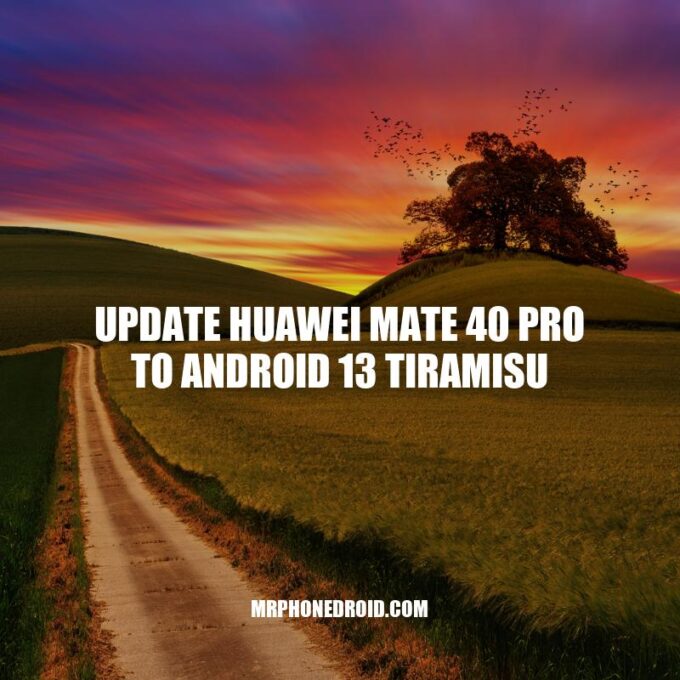The Huawei Mate 40 Pro is one of the most advanced and innovative smartphones on the market, with a powerful Kirin 9000 processor, a stunning 6.76-inch OLED display, and a quad-camera setup with Leica lenses. However, even the best smartphones need to be updated regularly to improve their performance, fix bugs, enhance security, and add new features. The latest version of the Android operating system, Android 13 Tiramisu, is expected to bring significant improvements in terms of speed, usability, and privacy, as well as exciting features such as split-screen multitasking, enhanced augmented reality, and smart home controls. If you want to experience the benefits of Android 13 Tiramisu on your Huawei Mate 40 Pro, you may need to wait until the update is rolled out to your region and device automatically. However, you can also manually update your Huawei Mate 40 Pro to Android 13 Tiramisu by following a few simple steps using a firmware file and a USB cable. In this article, we will explain how to update Huawei Mate 40 Pro to Android 13 Tiramisu in detail, including the prerequisites, the firmware download and installation process, and the potential risks and benefits of this procedure.
Prerequisites for Updating Huawei Mate 40 Pro to Android 13 Tiramisu
Before you can update your Huawei Mate 40 Pro to Android 13 Tiramisu manually, you need to make sure that you have the following items and settings:
- A computer or laptop with Windows or Mac OS X
- The latest version of HiSuite software installed on your computer
- A USB cable with Type-C connectors
- A Huawei Mate 40 Pro device with at least 50% battery charge or connected to a power source
- A compatible firmware file for your Huawei Mate 40 Pro, which should match your model and build number. You can download the firmware file from the official website of Huawei or from trusted third-party websites such as Firmware Finder or XDA Developers. Make sure to choose the latest stable version of Android 13 Tiramisu and that it is suitable for your device’s region and network carrier.
- Developer Options and USB Debugging enabled on your Huawei Mate 40 Pro. To do so, go to Settings, About Phone, and tap on Build Number seven times to enable Developer Options. Then go back to Settings, Developer Options, and toggle on USB Debugging.
Once you have all of the prerequisites listed above, you can proceed to the next step of updating your Huawei Mate 40 Pro to Android 13 Tiramisu manually.
How do I update my Huawei mate?
To update your Huawei Mate, follow the steps below:
- Go to ‘Settings’ on your device
- Tap on ‘System’
- Tap on ‘Software update’
- Click on ‘Check for updates’
- If an update is available, click on ‘Download and Install’
Alternatively, you can also update your Huawei Mate using the Huawei website. The steps are as follows:
- Visit the Huawei website and go to the ‘Support’ section
- Select your device and model number
- Click on ‘Downloads’ and select the latest firmware available
- Download and transfer the firmware to your device
- Open the ‘Files’ app, locate the firmware, and install it
Note: Make sure to back up all your important data before updating your device.
Downloading and Extracting the Firmware File for Huawei Mate 40 Pro
To download and extract the firmware file for Huawei Mate 40 Pro, follow these steps:
- Visit the official website of Huawei or one of the trusted third-party websites that offer firmware files for Huawei devices.
- Search for the latest version of Android 13 Tiramisu for your Huawei Mate 40 Pro model and build number.
- Download the firmware file to your computer and save it to a folder that you can easily access, such as Downloads or Desktop.
- Extract the firmware file using a file archive program such as WinRAR or 7-Zip. To do so, right-click on the firmware file and select Extract here or Extract to [filename].
- Wait for the extraction process to complete, which may take a few minutes depending on the size of the firmware file and your computer’s performance.
- You should get three files after extraction; a .app, a .xml, and a .txt file.
Once you have the firmware files extracted, you can proceed to the next step of updating your Huawei Mate 40 Pro to Android 13 Tiramisu manually. Here is a table that shows some of the main features and changes that Android 13 Tiramisu is expected to bring to Huawei Mate 40 Pro:
| Feature | Description |
|---|---|
| Performance optimization | Better memory management, faster app launching, and lower power consumption thanks to the optimized Android RunTime and Dalvik Virtual Machine. |
| Privacy improvements | More granular control over app permissions, stronger protection against malware and phishing, and faster security patches through Google Play Protect and monthly security updates. |
| New features and apps | A revamped Google Assistant, adaptive widgets, floating windows, and improved screenshots, as well as potential new apps from Google or third-party developers. |
| Compatibility changes | Some older or less popular apps may not work properly with Android 13 Tiramisu due to changes in the coding or APIs. This may affect certain games, social media apps, or productivity tools. |
| Localization and personalization | New language options, fonts, wallpapers, and themes, as well as personalized recommendations and settings based on your usage patterns and preferences. |
Enabling the Developer Options and USB Debugging on Huawei Mate 40 Pro
Before you can install Android 13 Tiramisu manually on your Huawei Mate 40 Pro, you need to enable the Developer Options and USB Debugging. Here’s how to do it:
- Open the Settings app on your Huawei Mate 40 Pro.
- Scroll down and tap on About phone.
- Scroll down to the Build number entry and tap on it seven times in rapid succession. You should see a message that says “You are now a developer!”
- Go back to the main Settings screen and tap on System and then on Developer options.
- Slide the toggle switch next to Developer options to turn it on.
- Scroll down to find the USB debugging option and check the box next to it. You may also need to enable OEM unlocking and USB debugging(Feb 2021+) in some models.
- Tap on OK to confirm the warning message about USB debugging.
Now, your Huawei Mate 40 Pro is ready to connect to your computer and transfer data between them via USB. In the next paragraph, we will show you how to do this and enter the Download mode on your device.
How do I enable USB debugging on my Huawei?
To enable USB debugging on a Huawei device, follow these steps:
1. Go to Settings on your Huawei device
2. Scroll down to About phone and tap on it
3. Find the Build number option and tap on it seven times until you see a message saying “You are now a developer”
4. Go back to the main Settings menu and scroll down to Developer options
5. Enable Developer options by toggling the switch at the top right corner
6. Scroll down to USB debugging and toggle the switch to enable it
7. A pop-up message might appear asking you to confirm. Tap on OK.
Note: The steps may vary depending on the specific model and version of your Huawei device.
For more detailed instructions or if you encounter any issues, you can refer to Huawei’s official website or community forums. You can also check out third-party websites such as XDA Developers which offer useful guides and tips for Huawei and other Android devices.
Connecting the Device to the Computer and Booting into Download Mode
To update your Huawei Mate 40 Pro to Android 13 Tiramisu manually, you need to connect it to your computer and boot it into Download mode. Follow these steps:
- Connect your Huawei Mate 40 Pro to your computer using a USB cable.
- Open the HiSuite program on your computer. If you don’t have it, you can download it from the Huawei website.
- On your Huawei Mate 40 Pro, press and hold the Volume Down button and then connect it to your computer via USB.
- Keep holding the Volume Down button until your device enters the Download mode. You should see an image of a smartphone and a green circle logo on the screen.
- In HiSuite, you should now see your device detected and listed under the “Connected devices” section. If not, try disconnecting and reconnecting the USB cable, or check if you have the correct USB drivers installed on your computer.
Once you have successfully connected your Huawei Mate 40 Pro to your computer and entered the Download mode, you can proceed to the next step of installing the firmware file. However, be aware that this process may erase your data, so make sure to back up your important files and apps beforehand. In the next paragraph, we will show you how to install the firmware and update your Huawei Mate 40 Pro to Android 13 Tiramisu.
How do I connect my Huawei screen to my computer?
To connect your Huawei screen to your computer, you will need an HDMI cable that has a HDMI port on both ends. Here are the steps to follow:
1. Connect one end of the HDMI cable to the HDMI port on your Huawei screen.
2. Connect the other end of the HDMI cable to the HDMI port on your computer.
3. Turn on your Huawei screen and switch to the HDMI input.
4. Your computer should automatically detect the Huawei screen and extend the display to it. If not, go to your computer’s display settings and select the Huawei screen as the second display.
If your computer doesn’t have an HDMI port, you can use a VGA or DVI adapter to connect the Huawei screen to your computer.
For more detailed instructions, you can check the Huawei website or the user manual that came with your Huawei screen.
Installing the Firmware
To upgrade your Huawei Mate 40 Pro to Android 13 Tiramisu manually, you will need to install the firmware file that matches your device’s model and build number. Follow these steps:
- Launch HiSuite on your computer if it’s not already open.
- Click on the “Update” option in the top menu bar and select “Update mode”.
- Select “Local update” and browse to the folder where you extracted the firmware file in step 3.
- Select the firmware file and click on “Open“.
- Read and accept the disclaimer and wait for the software to verify the file integrity.
- Click on “Update now” and wait for the software to package and transfer the firmware to your device.
- Do not disconnect your Huawei Mate 40 Pro from the computer during the update process and keep it connected until the update is complete.
- Once the update is finished, your device will automatically reboot and start optimizing the apps and system.
- Wait for your Huawei Mate 40 Pro to boot up and verify that the new Android 13 Tiramisu version is installed by checking the “About phone” section in the Settings app.
If you encounter any error or interruption during the firmware installation, check the HiSuite log for error codes and try to troubleshoot them using the HiSuite help page or the Huawei online community. Also, note that downgrading to a previous Android version may not be possible or recommended, so make sure to back up your data before proceeding with this manual update. In the next paragraph, we will provide some final steps to complete the process and ensure that your Huawei Mate 40 Pro is functioning correctly with Android 13 Tiramisu.
How to upgrade Huawei Mate 8?
To upgrade your Huawei Mate 8, you can follow the steps below:
1. Go to your phone’s settings and click on “System Update”.
2. Tap on “Check for Updates”.
3. If an update is available, click on “Download and Install”.
4. Wait for the update to download and install.
5. Your phone will automatically reboot once the update has been installed.
Alternatively, you can also upgrade your Huawei Mate 8 using the HiSuite software on your computer. You can download the latest HiSuite from the official Huawei website.
It’s important to note that before upgrading your phone, you should back up your data to prevent any potential loss.
Overall, upgrading your Huawei Mate 8 is a simple process and ensures that you have access to the latest software updates and features.
| Steps | Description |
|---|---|
| 1 | Go to your phone’s settings and click on “System Update”. |
| 2 | Tap on “Check for Updates”. |
| 3 | If an update is available, click on “Download and Install”. |
| 4 | Wait for the update to download and install. |
| 5 | Your phone will automatically reboot once the update has been installed. |
- Ensure to backup your data before upgrading.
- HiSuite can also be used to upgrade Mate 8 through computer.
- Download HiSuite from official Huawei website.
Final Steps and Conclusion
After updating your Huawei Mate 40 Pro to Android 13 Tiramisu manually, there are a few final steps you should take to ensure that your device is working optimally and safely. Here are some tips:
- Restart your device to clear any cache and refresh the system.
- Check for new updates regularly by going to Settings > System and updates > Software update and tapping “Download and install” if available.
- Delete any unnecessary apps, files, or data to free up storage space and enhance performance. You can use the HiSuite Data Backup app to save your important data to your computer or cloud storage before deleting them.
- Reset your network settings if you encounter any Wi-Fi or Bluetooth connectivity issues after the update. Go to Settings > System and updates > Reset > Network settings reset and confirm.
- Install new security patches and updates as soon as they are available to avoid potential risks and malware attacks. You can also enable the “Find My Phone” and “Protect apps” features in the Security app for extra protection.
In conclusion, updating your Huawei Mate 40 Pro to Android 13 Tiramisu manually is a simple and rewarding process if done correctly. By following the steps in this guide, you can enjoy faster speed, smoother performance, improved privacy and security, and new features that make your device more versatile and user-friendly. However, be aware that this process may void your warranty or introduce unexpected issues if not performed with caution and care. Therefore, make sure to read the instructions carefully, back up your data, and seek help from official sources or experts if needed. With these tips in mind, you can upgrade your Huawei Mate 40 Pro to Android 13 Tiramisu confidently and enjoy the benefits of the latest Android version.




